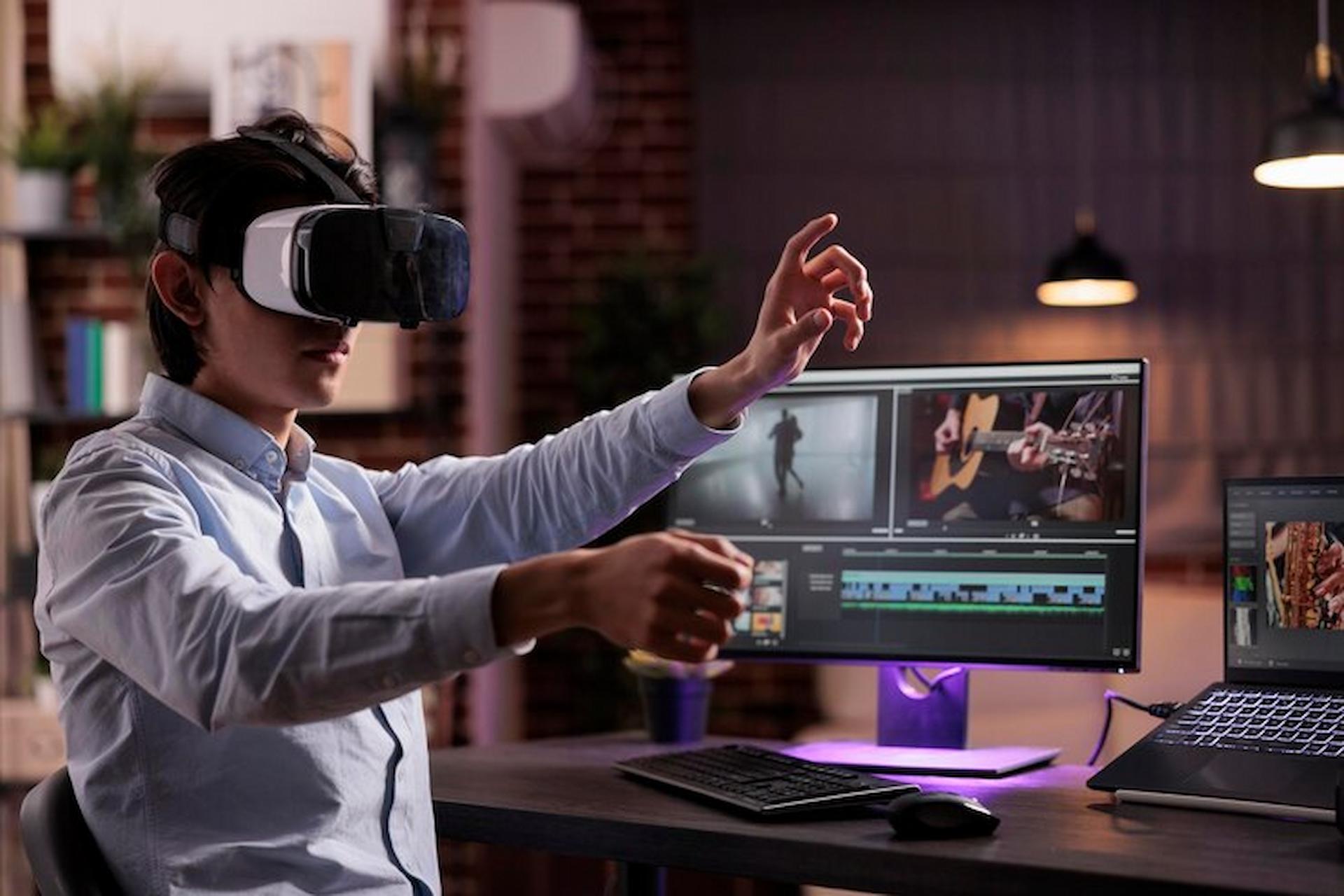
Virtual reality (VR) is transforming how we consume content. Explore how VR video production is revolutionizing the future of interactive experiences in gaming, education, entertainment, and marketing.
The digital landscape is evolving unprecedentedly, and virtual reality (VR) is at the forefront of this transformation. Once seen as a technology of the future, VR is now a powerful tool used in various industries, reshaping the way people engage with content. From immersive video games to interactive marketing experiences, VR video production opens new doors, offering creators and audiences unique opportunities to connect on deeper levels. Simultaneously, drone photography innovations enhance the quality of these experiences by providing breathtaking aerial perspectives and more dynamic visuals.
But why is VR video production gaining so much traction? And how exactly is it shaping the future of interactive content? Let’s dive deep into the world of virtual reality video production and explore its immense potential for entertainment, education, and beyond.
The Rise of VR Video Production in Entertainment
Virtual reality has quickly become a game-changer in the entertainment industry. From VR movies to video games, this technology offers unprecedented immersion, making viewers feel like they’re part of the action. Traditional media formats can no longer compete with VR’s level of interaction and engagement.
For instance, Hollywood filmmakers and content creators are now incorporating VR video production to create 360-degree experiences that transporting viewers into the movie. Whether flying through a city like a superhero or being on stage with your favorite musician, VR makes it all possible.
Some key trends that are shaping VR in entertainment include:
- 360-degree films: Offering a fully immersive view in every direction.
- Virtual concerts: Allowing fans to feel like they are front-row at significant performances.
- VR gaming: Elevating player engagement with realistic, interactive environments.
These immersive experiences have begun to replace traditional viewing habits, with industry experts predicting that the VR entertainment market will surpass $100 billion globally.
The Role of Drone Photography in Enhancing VR Video
Drone photography is increasingly important in creating stunning visuals for VR video production. The ability to capture breathtaking aerial shots provides an extra layer of depth and realism to VR experiences. Whether filming expansive natural landscapes or zooming through tight urban environments, drones add a dynamic perspective that enhances the overall immersive experience.
Combined with VR technology, drone footage allows for an even more engaging experience, as viewers can explore the virtual space 360 degrees from any angle. This combination is potent in industries like real estate, tourism, and event coverage, where users can virtually tour properties or destinations in high definition.
Some ways drone photography is enhancing VR include:
- Aerial tours: Enabling viewers to see destinations from a bird’s-eye view.
- Real estate virtual tours: Giving potential buyers a full 360-degree view of properties inside and out.
- Event coverage: Offering immersive experiences from concerts, festivals, and sporting events with dynamic aerial shots.
By integrating drone photography, VR videos become more visually striking, further amplifying the viewer’s experience.
Education and Training: A New Frontier for VR Video
The application of VR video in education is revolutionizing how students and professionals learn and acquire skills. Unlike traditional classroom settings, VR offers an experiential approach to learning, where individuals can immerse themselves in a subject and interact with it in real time.
From virtual field trips to historical landmarks to advanced medical training simulations, VR provides learners an enriched, interactive environment that enhances comprehension and retention. Schools, universities, and companies leverage this technology to create engaging learning modules.
Consider these uses of VR in education:
- Virtual labs: Allowing students to conduct science experiments without real-world risks.
- Historical reconstructions: Taking students back in time to witness historical events firsthand.
- Medical training: Providing realistic simulations for surgeons and healthcare workers to practice procedures in a risk-free environment.
Statistics show that VR-based training can improve learning retention by 60%, as learners tend to remember more from interactive experiences than reading textbooks or watching videos.
VR in Marketing: Creating Interactive and Memorable Experiences
In marketing, standing out in a crowded digital space is critical. Brands increasingly turn to VR video production to engage customers in novel ways. VR allows businesses to provide immersive experiences that give users a deeper connection with their products or services, leading to higher conversion rates and customer loyalty.
Imagine trying out a product or experiencing a service before making a purchase. VR makes that possible. Customers can virtually tour a property, test-drive a car, or even “try on” clothes from their homes. This hands-on approach enhances customer engagement and builds trust.
Key benefits of VR in marketing include:
- Product demonstrations: Allowing customers to experience products in a virtual setting.
- Interactive ads: Offering users a fully immersive experience rather than a passive one.
- Branded VR experiences: Creating unique, shareable content that users can engage with and spread on social media.
As virtual marketing campaigns become more widespread, businesses integrating VR into their strategies will see significant returns in user engagement and brand loyalty.
How VR Video Is Shaping the Future of Gaming
The gaming industry has always been at the cutting edge of technology, and VR is no exception. VR video production is taking gaming to the next level, offering players experiences that are more immersive, interactive, and engaging than ever before.
Virtual reality gaming places players directly inside the game world, where they can interact with objects, characters, and environments in ways that traditional gaming simply cannot. Whether fighting dragons in a fantasy world or exploring the ocean’s depths, VR allows you to be a part of the game, not just a spectator.
Critical advancements in VR gaming include:
- Motion tracking: Allowing players to move their bodies and see those movements replicated in the game.
- Haptic feedback: Providing physical sensations that match the in-game experience, making it feel more natural.
- Multiplayer VR worlds: Letting players collaborate or compete with others in real-time within a fully immersive environment.
With VR gaming projected to grow by over 32% annually, this technology looks increasingly dominant in the gaming future.
The Future of VR Video: What’s Next?
As VR technology evolves, the future holds even more exciting possibilities. We are already seeing significant strides in the quality of VR video production, from more realistic graphics to more immersive storytelling techniques. However, the next wave of VR innovations will likely focus on making the technology more accessible, affordable, and user-friendly for everyday consumers.
Some emerging trends that are expected to emerge in the future include:
- Wireless VR headsets: Improving the convenience and mobility of VR experiences.
- Cloud VR: Allowing users to stream VR content without needing high-end hardware.
- Augmented reality (AR) integration: Merging VR with real-world elements to create mixed-reality experiences.
In addition, industries like retail, tourism, and education are expected to adopt VR video production at even greater scales, making it a standard for interactive content consumption. VR is set to reshape how we engage with content and how we live, work, and play.
Final Thoughts
Virtual reality video production is not just a technological trend—it is shaping the future of how we experience content. Whether revolutionizing entertainment, enhancing education, transforming marketing, or taking gaming to new heights, VR offers unparalleled opportunities for creating interactive and immersive experiences. By integrating technologies like drone photography, VR production becomes even more dynamic, allowing content creators to craft breathtaking virtual worlds that captivate audiences.
As technology evolves, businesses and creators who embrace VR video will stand at the cutting edge of interactive content, leading the charge into a more immersive future. Now is the time to explore VR’s vast possibilities and how it can elevate your content, whether in entertainment, education, or marketing.



